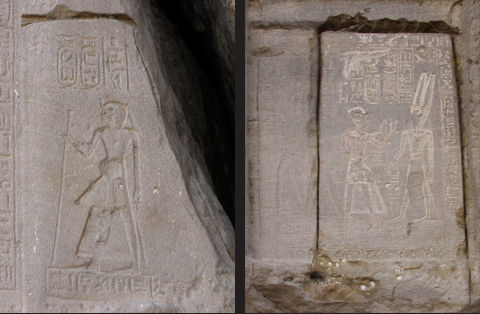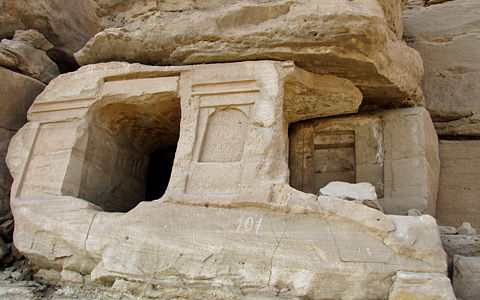Gebel Silsila
Gebel Silsila is the name given to a rocky gorge between Kom Ombo and Edfu where the River Nile narrows and high sandstone cliffs come right down to the water’s edge.
(Silsila is an Arabic word means a chain
On both banks of the Nile the massive quarries produced the sandstone needed for the prolific construction of monuments during Dynasty XVIII, at first in small quantities and as the skills of the workmen grew, the stone was more extensively quarried to build great monuments such as the colonnade of Amenhotep III at Luxor, the Karnak Temple of Amenhotep IV, the Ramesseum and Medinet Habu, to name but a few. By Ptolemaic times most of the Upper Egyptian temples contained monuments built from Gebel Silsila sandstone. Because of the sanctity of the site, the sandstone was considered to have an extra holiness.
It is hardly surprising that by the 18th Dynasty , travellers had developed the custom of carving small shrines into the cliffs here, dedicating them to a variety of Nile gods and to the river itself. Smaller shrines were cut by Tuthmose I, Hatshepsut and Tuthmose III, before Horemheb constructed his rock-cut temple here, then many of the 19th Dynasty or later kings left their mark in some way. Gebel Silsila became an important cult centre and each year at the beginning of the season of inundation offerings and sacrifices were made to the gods associated with the Nile to ensure the country’s well being for the coming year.
Gebel Silsila West
The steep sandstone cliffs of the West Bank are cluttered with grafitti, shrines and stelae, including 33 rock chapels. Dynasty XVIII saw the construction of shrines by Tuthmose I, Hatshepsut, Tuthmose III and Horemheb and in Dynasty XIX, Rameses II, Merenptah, Siptah, Seti II, Rameses III and Rameses V had elaborate stelae carved on the rocks. Seti I left an inscribed Hymn to the Nile and inaugurated two festivals, which were continued to be endowed by Rameses II and Merenptah.
Further north, the visitor can see the majority of rock-shrines, some with elaborate chapels containing statues of the owners and with beautiful decorated ceilings. Many of these shrines have been damaged by quarrying or earthquakes and are now open to the elements, but they can be seen from the wide path that runs along the river bank. The shrines belong to high officials, priests, royal scribes and nobles of the time. There is also a Dynasty XVIII tomb belonging to Sennefer, a libation priest from Thebes who was buried here with his wife Hatshepsut. The tomb is now open to the sky, and the remains of five seated statues as well as hieroglyphic inscriptions can be seen, close to the water’s edge.
rock-chapel of Horemheb :-
who was the last king of the 18th Dynasty The chapel was dedicated to Amun-Re as well as other deities that were connected to the River Nile.
The monument consists of a façade of five doorways separated by pillars of differing widths, behind which is a long transverse hall with vaulted roof and a smaller oblong chamber, the sanctuary, to the rear.
The western wall depicts one of the most noted reliefs of Horemheb, the king’s ‘Triumphal Procession’ after his victory in Nubia. Horemheb is shown seated on a portable lion-chair which is carried by twelve soldiers wearing plumes of feathers. At the front and back of the king are his fan-bearers, protecting Pharaoh from the sun. His entourage include rows of priests, soldiers, a trumpeter and several groups of captured prisoners, all depicted in a very natural style, almost echoing some of the Amarna Period reliefs. The inscription above the king extols his victory over the people of Kush.
Another important relief here depicts a list of four Heb-sed festivals of Rameses II in the 30th, 34th, 37th and 40th years of his reign, which were supervised by his eldest son, Prince Khaemwaset. This prince, renowned for his priestly wisdom as well as his restoration works, appears in several places in the chapel, along with his mother Queen Asetnefert and Princess Bentanta, as well as other favoured officials of the reign. Khaemwaset presumably died before the 42nd jubilee of Rameses II was celebrated at Gebel Silsila as this was conducted by the Vizier Khay, who also has a presence in the speos. Merenptah, the son and successor of Rameses II is depicted on a stele with his wife Asetnefert and his Vizier Panehesy adoring Amun-Re and Mut.
On the northern end wall there is a niche with six figures cut in high relief, depicting (from west to east) the Vizier Panehesy, the goddess Ma’at, a male relation Amennakht, a female relation ‘Songstress of Hathor’, the god Ptah and finally Ra’y, a female relation with the title ‘Songstress of Re’. This is a rare relief where a private family is seen in the presence of the gods. Many other stelae and reliefs line the walls of the hall, giving the names of Dynasty XIX kings and their officials.
Gebel Silsila East
The east bank of the Nile contains the more spectacular quarries of Gebel Silsila which were most exploited during the New Kingdom, particularly under Rameses II, who employed three thousand workers to cut stone for the construction of the Ramesseum on the west bank at Thebes. Many shrines and stelae were cut into the rock here too and the names of kings who worked the quarries are attested by their officials who gave detailed accounts of their work.















